Nghiên cứu sự tích hợp của giao tiếp liên văn hóa trong dạy và học ngoại ngữ
Hơn 30 năm qua, tiếng Anh đã đóng một vai trò quan trọng như là một ngôn ngữ giao tiếp quốc tế
ở Việt Nam. Hiện tại, tiếng Anh được dạy chính thức cho người học ở Việt Nam bắt đầu từ lớp ba.
Trước đây, việc dạy và học tiếng Anh thường tập trung vào các chức năng và cách sử dụng của
tiếng Anh. Thực tế cho thấy mặc dù thành thạo tiếng Anh nhưng hầu hết sinh viên Việt Nam sau
khi tốt nghiệp đại học không thể giao tiếp bằng tiếng Anh hiệu quả với đồng nghiệp từ các nền văn
hóa khác nhau. Do đó, mục tiêu của nghiên cứu này là phân tích quan điểm của sinh viên chuyên
ngành tiếng Anh năm thứ hai và thứ ba về việc phát triển năng lực liên văn hóa trong dạy và học
ngoại ngữ tại Khoa Ngoại ngữ, Đại học Thái Nguyên. Các kết quả nghiên cứu cho thấy người học
không có đủ thông tin văn hóa và rất hiếm khi hoặc không bao giờ tham gia vào những bàn luận về
các giá trị, niềm tin, thái độ và hành vi của những người sống trong các nền văn hóa khác. Rõ ràng,
khả năng phát triển năng lực liên văn hóa chưa được khai thác triệt để trong lớp học và dạy ngoại
ngữ. Do đó, quá trình dạy và học tiếng Anh cần tập trung mạnh mẽ hơn vào phát triển năng lực
liên văn hóa phù hợp với các yêu cầu và mục tiêu giáo dục hiện nay.
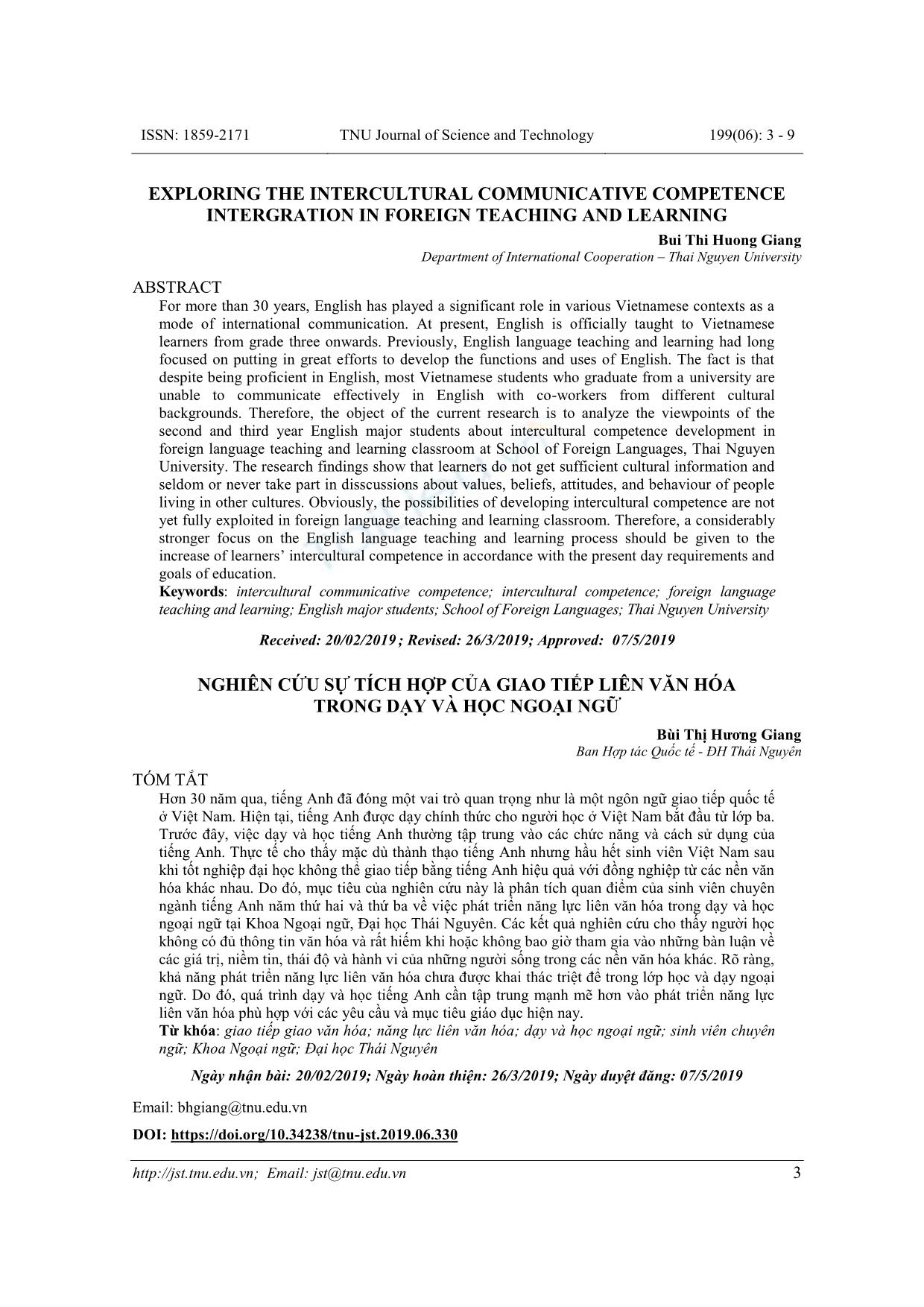
Trang 1
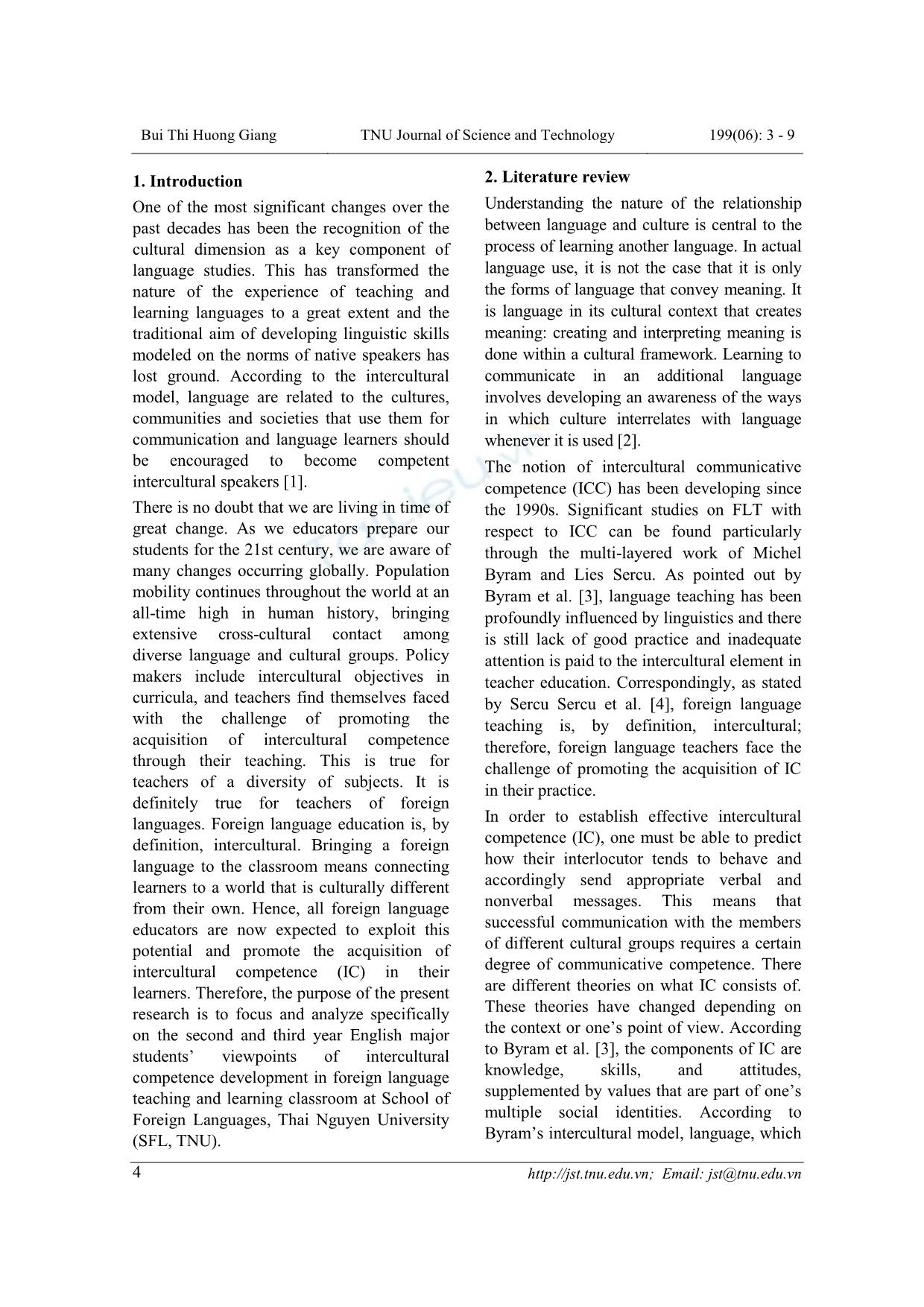
Trang 2
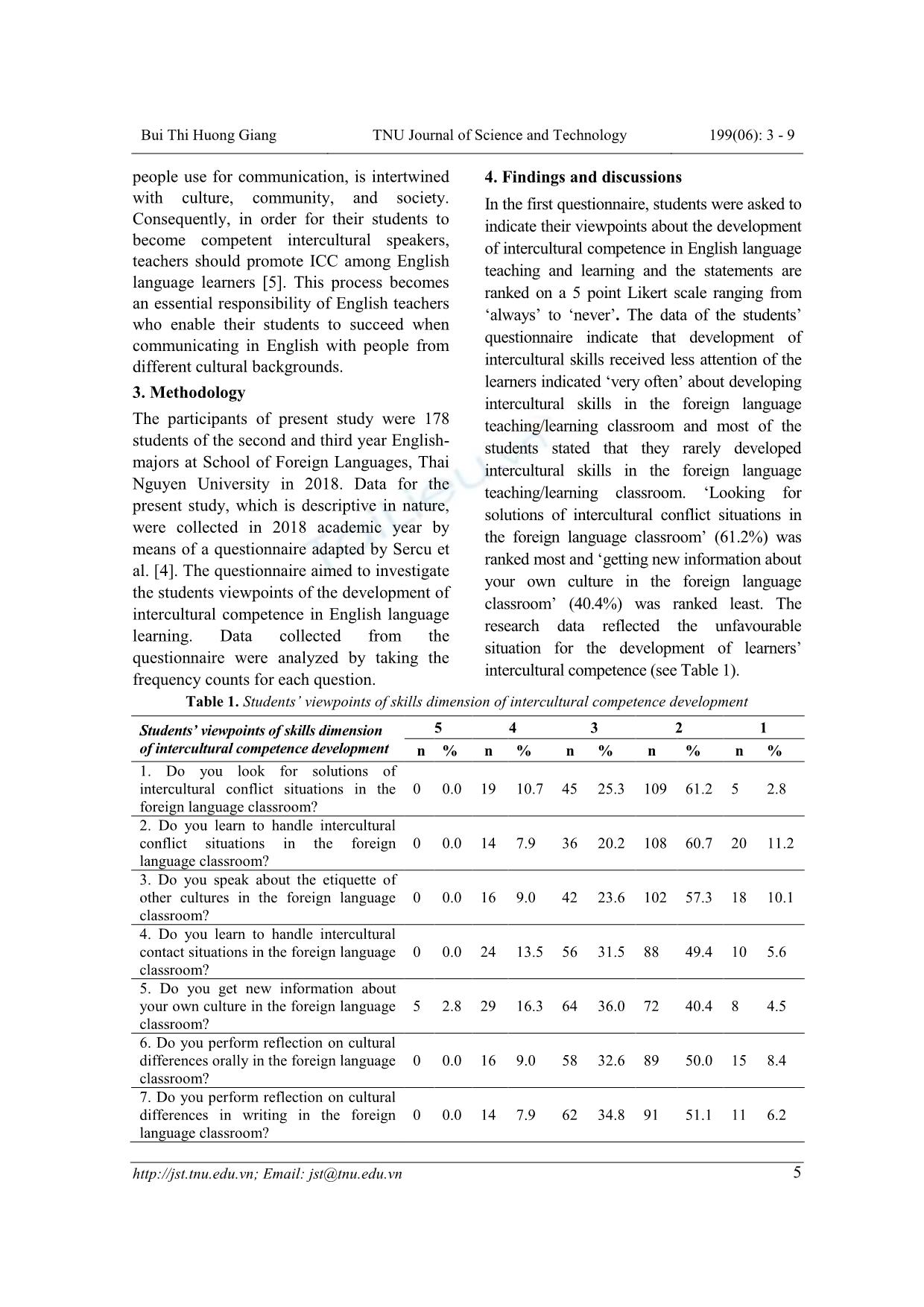
Trang 3
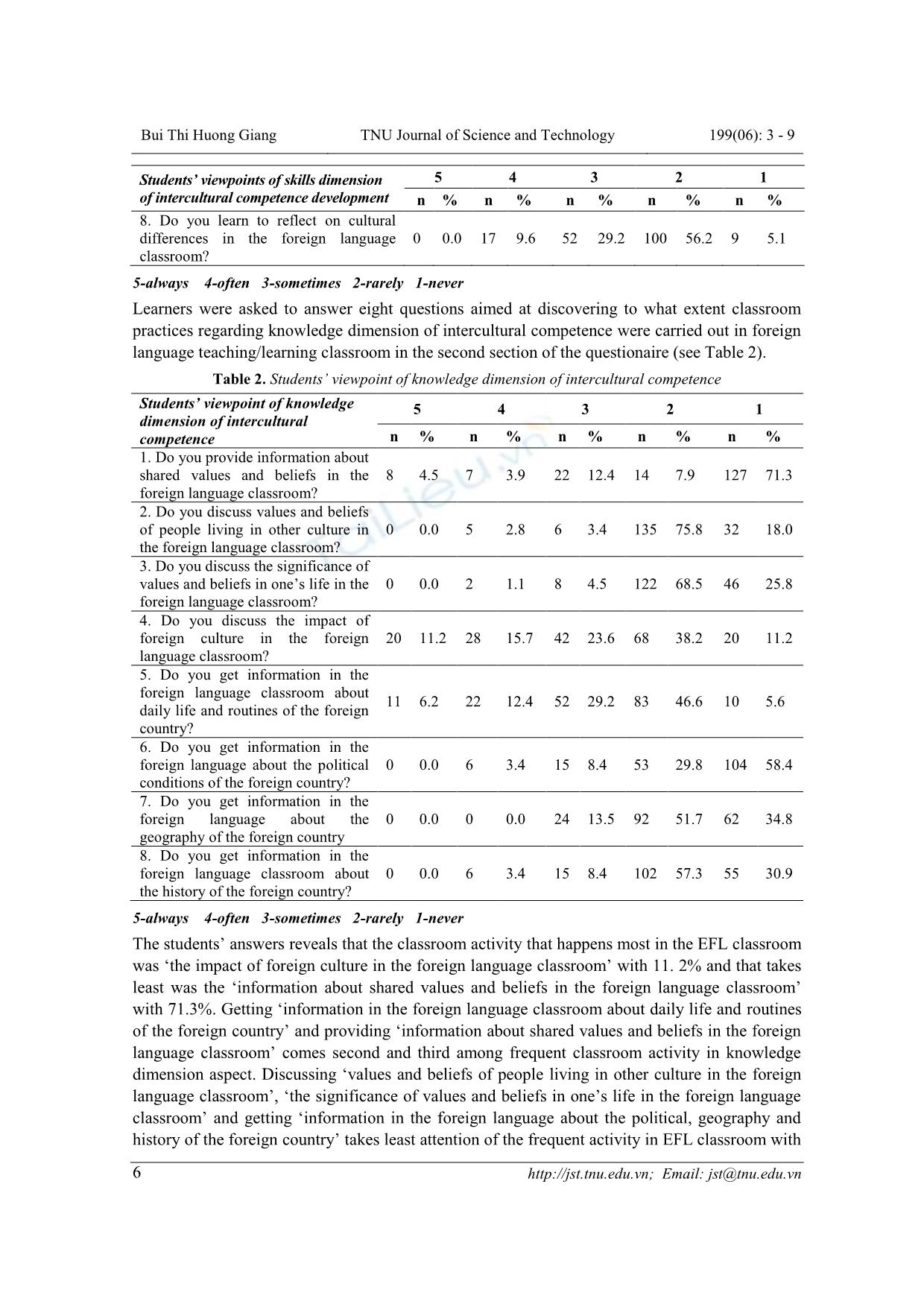
Trang 4
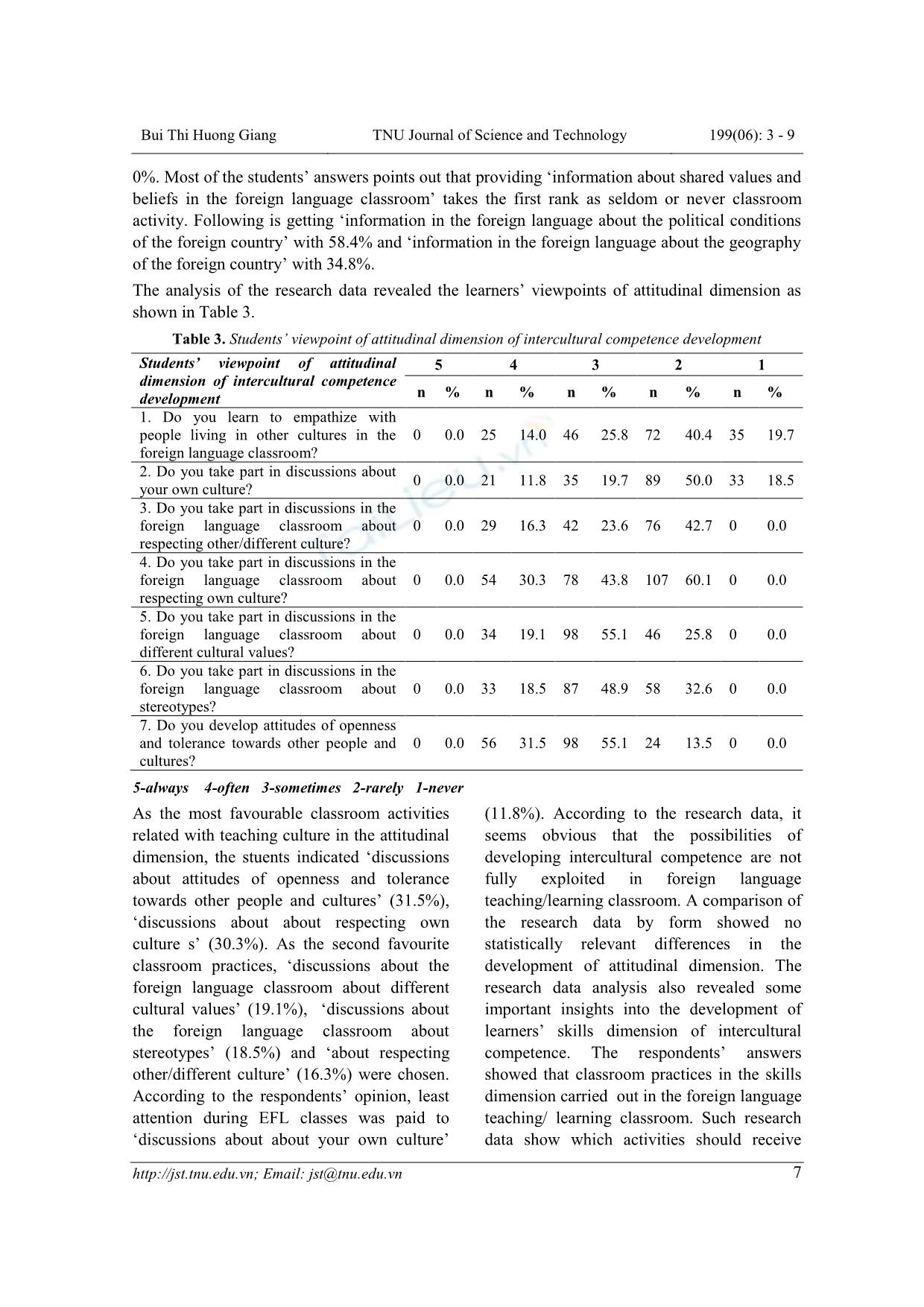
Trang 5
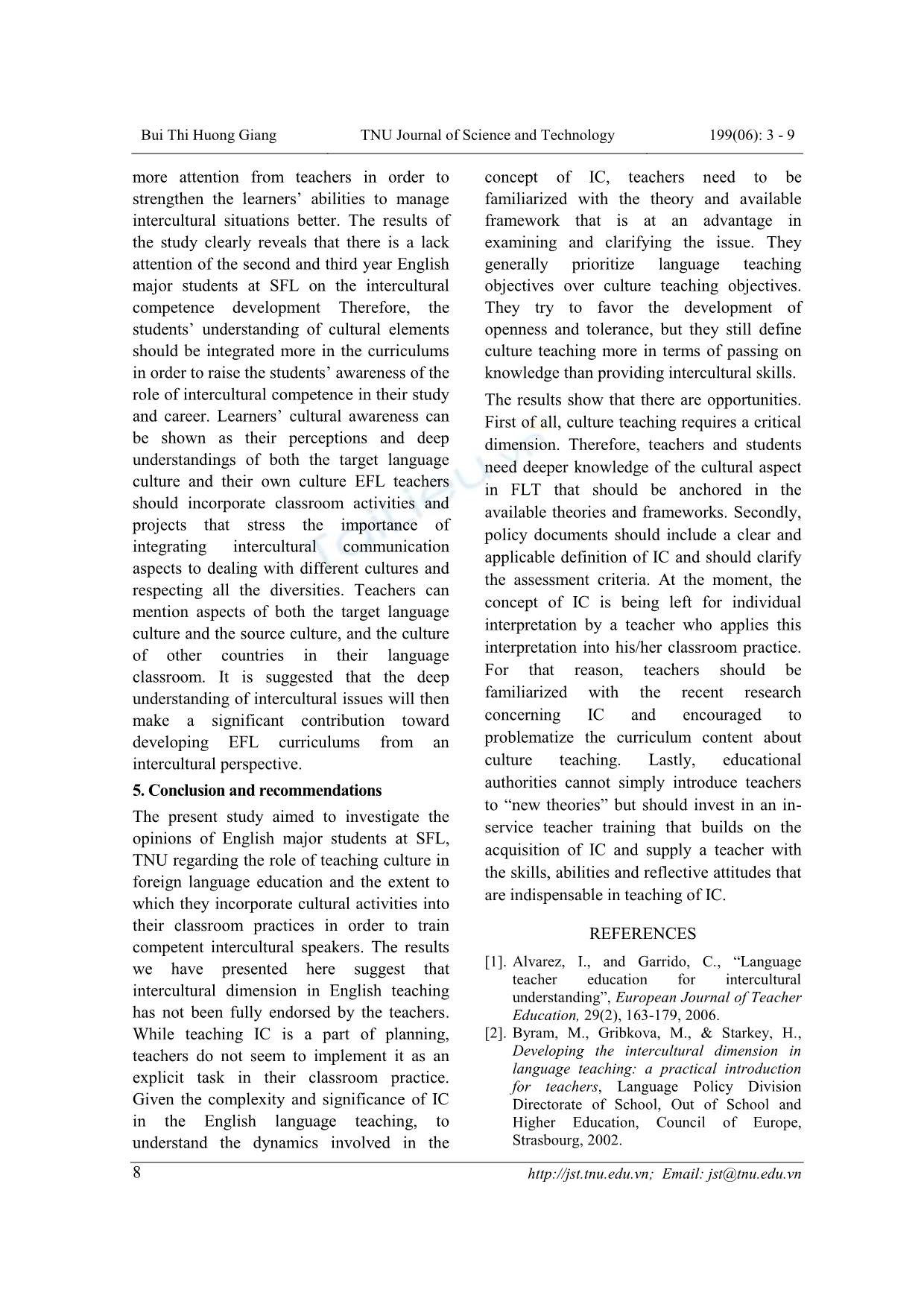
Trang 6

Trang 7
Tóm tắt nội dung tài liệu: Nghiên cứu sự tích hợp của giao tiếp liên văn hóa trong dạy và học ngoại ngữ
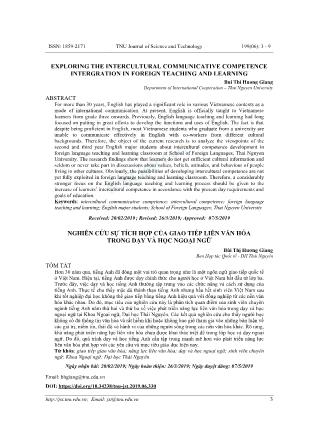
redict how their interlocutor tends to behave and accordingly send appropriate verbal and nonverbal messages. This means that successful communication with the members of different cultural groups requires a certain degree of communicative competence. There are different theories on what IC consists of. These theories have changed depending on the context or one‟s point of view. According to Byram et al. [3], the components of IC are knowledge, skills, and attitudes, supplemented by values that are part of one‟s multiple social identities. According to Byram‟s intercultural model, language, which Bui Thi Huong Giang TNU Journal of Science and Technology 199(06): 3 - 9 Email: jst@tnu.edu.vn 5 people use for communication, is intertwined with culture, community, and society. Consequently, in order for their students to become competent intercultural speakers, teachers should promote ICC among English language learners [5]. This process becomes an essential responsibility of English teachers who enable their students to succeed when communicating in English with people from different cultural backgrounds. 3. Methodology The participants of present study were 178 students of the second and third year English- majors at School of Foreign Languages, Thai Nguyen University in 2018. Data for the present study, which is descriptive in nature, were collected in 2018 academic year by means of a questionnaire adapted by Sercu et al. [4]. The questionnaire aimed to investigate the students viewpoints of the development of intercultural competence in English language learning. Data collected from the questionnaire were analyzed by taking the frequency counts for each question. 4. Findings and discussions In the first questionnaire, students were asked to indicate their viewpoints about the development of intercultural competence in English language teaching and learning and the statements are ranked on a 5 point Likert scale ranging from „always‟ to „never‟. The data of the students‟ questionnaire indicate that development of intercultural skills received less attention of the learners indicated „very often‟ about developing intercultural skills in the foreign language teaching/learning classroom and most of the students stated that they rarely developed intercultural skills in the foreign language teaching/learning classroom. „Looking for solutions of intercultural conflict situations in the foreign language classroom‟ (61.2%) was ranked most and „getting new information about your own culture in the foreign language classroom‟ (40.4%) was ranked least. The research data reflected the unfavourable situation for the development of learners‟ intercultural competence (see Table 1). Table 1. Students’ viewpoints of skills dimension of intercultural competence development Students’ viewpoints of skills dimension of intercultural competence development 5 4 3 2 1 n % n % n % n % n % 1. Do you look for solutions of intercultural conflict situations in the foreign language classroom? 0 0.0 19 10.7 45 25.3 109 61.2 5 2.8 2. Do you learn to handle intercultural conflict situations in the foreign language classroom? 0 0.0 14 7.9 36 20.2 108 60.7 20 11.2 3. Do you speak about the etiquette of other cultures in the foreign language classroom? 0 0.0 16 9.0 42 23.6 102 57.3 18 10.1 4. Do you learn to handle intercultural contact situations in the foreign language classroom? 0 0.0 24 13.5 56 31.5 88 49.4 10 5.6 5. Do you get new information about your own culture in the foreign language classroom? 5 2.8 29 16.3 64 36.0 72 40.4 8 4.5 6. Do you perform reflection on cultural differences orally in the foreign language classroom? 0 0.0 16 9.0 58 32.6 89 50.0 15 8.4 7. Do you perform reflection on cultural differences in writing in the foreign language classroom? 0 0.0 14 7.9 62 34.8 91 51.1 11 6.2 Bui Thi Huong Giang TNU Journal of Science and Technology 199(06): 3 - 9 Email: jst@tnu.edu.vn 6 Students’ viewpoints of skills dimension of intercultural competence development 5 4 3 2 1 n % n % n % n % n % 8. Do you learn to reflect on cultural differences in the foreign language classroom? 0 0.0 17 9.6 52 29.2 100 56.2 9 5.1 5-always 4-often 3-sometimes 2-rarely 1-never Learners were asked to answer eight questions aimed at discovering to what extent classroom practices regarding knowledge dimension of intercultural competence were carried out in foreign language teaching/learning classroom in the second section of the questionaire (see Table 2). Table 2. Students’ viewpoint of knowledge dimension of intercultural competence Students’ viewpoint of knowledge dimension of intercultural competence 5 4 3 2 1 n % n % n % n % n % 1. Do you provide information about shared values and beliefs in the foreign language classroom? 8 4.5 7 3.9 22 12.4 14 7.9 127 71.3 2. Do you discuss values and beliefs of people living in other culture in the foreign language classroom? 0 0.0 5 2.8 6 3.4 135 75.8 32 18.0 3. Do you discuss the significance of values and beliefs in one‟s life in the foreign language classroom? 0 0.0 2 1.1 8 4.5 122 68.5 46 25.8 4. Do you discuss the impact of foreign culture in the foreign language classroom? 20 11.2 28 15.7 42 23.6 68 38.2 20 11.2 5. Do you get information in the foreign language classroom about daily life and routines of the foreign country? 11 6.2 22 12.4 52 29.2 83 46.6 10 5.6 6. Do you get information in the foreign language about the political conditions of the foreign country? 0 0.0 6 3.4 15 8.4 53 29.8 104 58.4 7. Do you get information in the foreign language about the geography of the foreign country 0 0.0 0 0.0 24 13.5 92 51.7 62 34.8 8. Do you get information in the foreign language classroom about the history of the foreign country? 0 0.0 6 3.4 15 8.4 102 57.3 55 30.9 5-always 4-often 3-sometimes 2-rarely 1-never The students‟ answers reveals that the classroom activity that happens most in the EFL classroom was „the impact of foreign culture in the foreign language classroom‟ with 11. 2% and that takes least was the „information about shared values and beliefs in the foreign language classroom‟ with 71.3%. Getting „information in the foreign language classroom about daily life and routines of the foreign country‟ and providing „information about shared values and beliefs in the foreign language classroom‟ comes second and third among frequent classroom activity in knowledge dimension aspect. Discussing „values and beliefs of people living in other culture in the foreign language classroom‟, „the significance of values and beliefs in one‟s life in the foreign language classroom‟ and getting „information in the foreign language about the political, geography and history of the foreign country‟ takes least attention of the frequent activity in EFL classroom with Bui Thi Huong Giang TNU Journal of Science and Technology 199(06): 3 - 9 Email: jst@tnu.edu.vn 7 0%. Most of the students‟ answers points out that providing „information about shared values and beliefs in the foreign language classroom‟ takes the first rank as seldom or never classroom activity. Following is getting „information in the foreign language about the political conditions of the foreign country‟ with 58.4% and „information in the foreign language about the geography of the foreign country‟ with 34.8%. The analysis of the research data revealed the learners‟ viewpoints of attitudinal dimension as shown in Table 3. Table 3. Students’ viewpoint of attitudinal dimension of intercultural competence development Students’ viewpoint of attitudinal dimension of intercultural competence development 5 4 3 2 1 n % n % n % n % n % 1. Do you learn to empathize with people living in other cultures in the foreign language classroom? 0 0.0 25 14.0 46 25.8 72 40.4 35 19.7 2. Do you take part in discussions about your own culture? 0 0.0 21 11.8 35 19.7 89 50.0 33 18.5 3. Do you take part in discussions in the foreign language classroom about respecting other/different culture? 0 0.0 29 16.3 42 23.6 76 42.7 0 0.0 4. Do you take part in discussions in the foreign language classroom about respecting own culture? 0 0.0 54 30.3 78 43.8 107 60.1 0 0.0 5. Do you take part in discussions in the foreign language classroom about different cultural values? 0 0.0 34 19.1 98 55.1 46 25.8 0 0.0 6. Do you take part in discussions in the foreign language classroom about stereotypes? 0 0.0 33 18.5 87 48.9 58 32.6 0 0.0 7. Do you develop attitudes of openness and tolerance towards other people and cultures? 0 0.0 56 31.5 98 55.1 24 13.5 0 0.0 5-always 4-often 3-sometimes 2-rarely 1-never As the most favourable classroom activities related with teaching culture in the attitudinal dimension, the stuents indicated „discussions about attitudes of openness and tolerance towards other people and cultures‟ (31.5%), „discussions about about respecting own culture s‟ (30.3%). As the second favourite classroom practices, „discussions about the foreign language classroom about different cultural values‟ (19.1%), „discussions about the foreign language classroom about stereotypes‟ (18.5%) and „about respecting other/different culture‟ (16.3%) were chosen. According to the respondents‟ opinion, least attention during EFL classes was paid to „discussions about about your own culture‟ (11.8%). According to the research data, it seems obvious that the possibilities of developing intercultural competence are not fully exploited in foreign language teaching/learning classroom. A comparison of the research data by form showed no statistically relevant differences in the development of attitudinal dimension. The research data analysis also revealed some important insights into the development of learners‟ skills dimension of intercultural competence. The respondents‟ answers showed that classroom practices in the skills dimension carried out in the foreign language teaching/ learning classroom. Such research data show which activities should receive Bui Thi Huong Giang TNU Journal of Science and Technology 199(06): 3 - 9 Email: jst@tnu.edu.vn 8 more attention from teachers in order to strengthen the learners‟ abilities to manage intercultural situations better. The results of the study clearly reveals that there is a lack attention of the second and third year English major students at SFL on the intercultural competence development Therefore, the students‟ understanding of cultural elements should be integrated more in the curriculums in order to raise the students‟ awareness of the role of intercultural competence in their study and career. Learners‟ cultural awareness can be shown as their perceptions and deep understandings of both the target language culture and their own culture EFL teachers should incorporate classroom activities and projects that stress the importance of integrating intercultural communication aspects to dealing with different cultures and respecting all the diversities. Teachers can mention aspects of both the target language culture and the source culture, and the culture of other countries in their language classroom. It is suggested that the deep understanding of intercultural issues will then make a significant contribution toward developing EFL curriculums from an intercultural perspective. 5. Conclusion and recommendations The present study aimed to investigate the opinions of English major students at SFL, TNU regarding the role of teaching culture in foreign language education and the extent to which they incorporate cultural activities into their classroom practices in order to train competent intercultural speakers. The results we have presented here suggest that intercultural dimension in English teaching has not been fully endorsed by the teachers. While teaching IC is a part of planning, teachers do not seem to implement it as an explicit task in their classroom practice. Given the complexity and significance of IC in the English language teaching, to understand the dynamics involved in the concept of IC, teachers need to be familiarized with the theory and available framework that is at an advantage in examining and clarifying the issue. They generally prioritize language teaching objectives over culture teaching objectives. They try to favor the development of openness and tolerance, but they still define culture teaching more in terms of passing on knowledge than providing intercultural skills. The results show that there are opportunities. First of all, culture teaching requires a critical dimension. Therefore, teachers and students need deeper knowledge of the cultural aspect in FLT that should be anchored in the available theories and frameworks. Secondly, policy documents should include a clear and applicable definition of IC and should clarify the assessment criteria. At the moment, the concept of IC is being left for individual interpretation by a teacher who applies this interpretation into his/her classroom practice. For that reason, teachers should be familiarized with the recent research concerning IC and encouraged to problematize the curriculum content about culture teaching. Lastly, educational authorities cannot simply introduce teachers to “new theories” but should invest in an in- service teacher training that builds on the acquisition of IC and supply a teacher with the skills, abilities and reflective attitudes that are indispensable in teaching of IC. REFERENCES [1]. Alvarez, I., and Garrido, C., “Language teacher education for intercultural understanding”, European Journal of Teacher Education, 29(2), 163-179, 2006. [2]. Byram, M., Gribkova, M., & Starkey, H., Developing the intercultural dimension in language teaching: a practical introduction for teachers, Language Policy Division Directorate of School, Out of School and Higher Education, Council of Europe, Strasbourg, 2002. Bui Thi Huong Giang TNU Journal of Science and Technology 199(06): 3 - 9 Email: jst@tnu.edu.vn 9 [3]. Byram, M., Nichols, A. & Stevens, D.(eds)., Developing Intercultural Competence in Practice, Clevedon: Multilingual Matters, 2001. [4]. Liddicoat, A. J. & Scarino, A., Inercultural Language Teaching and Learning, Malden, MA: Wiley-Blackwell, 2013. [5]. Sercu, L., Bandura, E., Foreign language teachers and intercultural competence: an international investigation. UK: The Cromwell Press Ltd, 2005.
File đính kèm:
 nghien_cuu_su_tich_hop_cua_giao_tiep_lien_van_hoa_trong_day.pdf
nghien_cuu_su_tich_hop_cua_giao_tiep_lien_van_hoa_trong_day.pdf

